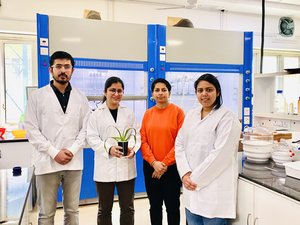China’s Chang’e-6 en route to retrieve samples from Moon’s far side

China’s Chang’e-6 on Friday successfully lifted off for the Moon’s far side to collect and bring back samples from the lunar surface, reports said.
A Long March-5 rocket, carrying the Chang’e-6 spacecraft, lifted off from the Wenchang Space Launch Site on the coast of the southern island province of Hainan on Friday afternoon, Xinhua news agency reported.
While this is China’s second mission to the Moon’s far side, as Chang’e-4 was the first to visit in 2019, it is the first time that dust samples will be collected from the area that never faces the Earth.
The probe aims to collect 2 kg samples from the lunar surface. Although Chang’e-5 in 2020 brought back nearly four pounds of regolith, it was from the Moon’s near side.
The US and the former Soviet Union have also successfully gathered samples from there and brought them back to Earth.
“Collecting and returning samples from the far side of the moon is an unprecedented feat. Now we know very little about the moon’s far side. If the Chang’e-6 mission can achieve its goal, it will provide scientists with the first direct evidence to understand the environment and material composition of the far side of the moon, which is of great significance,” Wu Weiren, an academician of the Chinese Academy of Engineering and chief designer of China’s lunar exploration programme, was quoted as saying by Xinhua.
The Chang’e-6 spacecraft comprises an orbiter, a lander, an ascender, and a returner. The probe also carries four payloads developed through international cooperation. Scientific instruments from France, Italy, and the European Space Agency are aboard the Chang’e-6 lander, while a small satellite from Pakistan is aboard the orbiter.
According to the China National Space Administration (CNSA), the Chang’e-6 lunar probe will land as well as collect samples from an impact crater known as the Apollo Basin, located within the South Pole-Aitken Basin on the far side of the Moon.
It will take a month for the probe to reach the lunar surface. After reaching, it will make a soft landing. Within 48 hours after landing, a robotic arm will be extended to scoop rocks and soil from the lunar surface, while a drill will be used to bore into the ground. Scientific detection work will be carried out simultaneously. After the samples are sealed in a container, the ascender will take off from the Moon and dock with the orbiter in lunar orbit.
The returner will then carry back the samples to Earth, landing in Siziwang Banner in north China’s Inner Mongolia Autonomous Region.
The entire mission is expected to last about 53 days, the CNSA said.
China’s ambitious space exploration programme also includes missions to Mars and asteroids. The Chang’e mission series, designed in the 1990s, is expected to launch Chang’e-7 to search for water at the lunar south pole, while Chang’e-8 will survey material in the same region to help build future space infrastructure.
The country also aims to send crewed missions to the moon by 2030 and is also working on establishing a permanent, international lunar research base in the 2030s.





